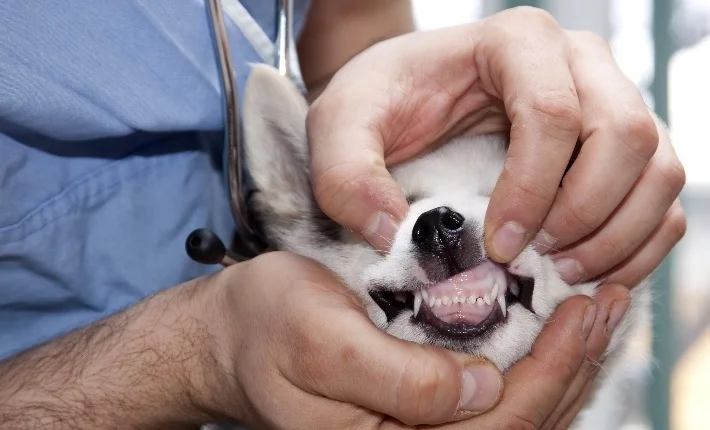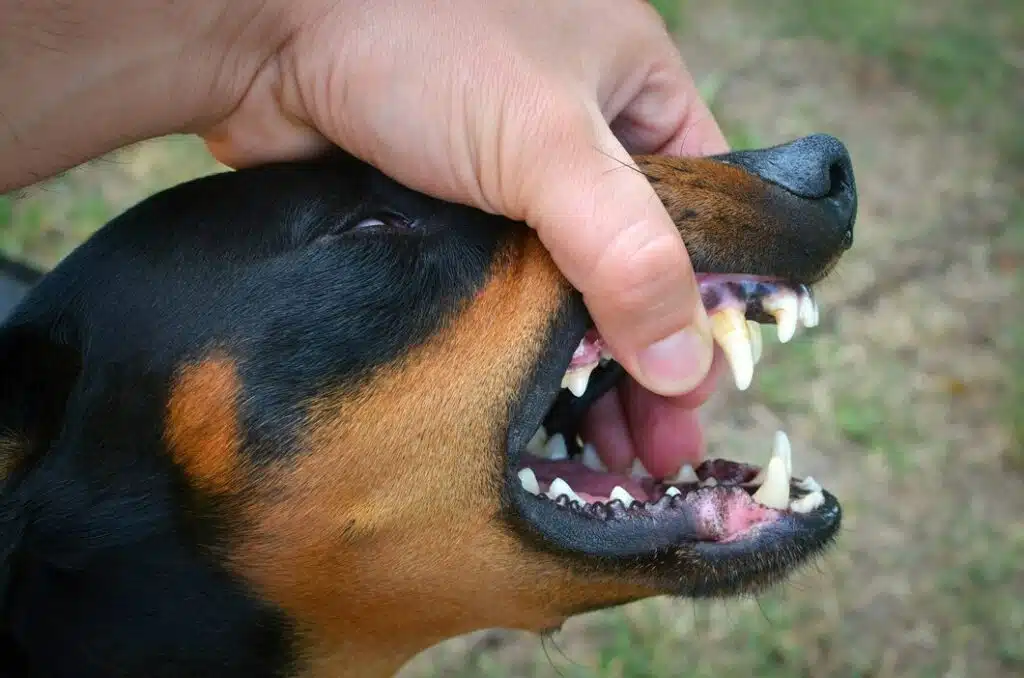In this article, we will explore the importance of understanding and addressing teething symptoms in dogs. Just like human babies, pups go through this teething stage as they raise and grow old. Dog dads or moms must be conscious of the signs and indications associated with this procedure, in order to provide apt care and support for their dogs.
Table of Contents
Teething is a usual part of a puppy’s life, but it can be a puzzling time for both the puppy and its owner. Understanding the teething process and being able to identify the symptoms can help ease discomfort and ensure the overall happiness of your pooch.
As a pet owner, it is our primary job to provide the necessary care during this crucial stage. By addressing teething symptoms in a highly concerned manner, we can help our dogs cross through this phase with negligible pain and avoid possible complications.
In this guide, we will cover:
- Usual signs of teething in dogs
- Tips for handling discomfort
- Potential issues that may arise during this period
By the end of this guide, you will have a complete picture of what to expect during your dog’s teething journey. Let’s get started!
Understanding the Teething Process in Puppies
Understanding the teething process in puppies is essential for dog owners to provide appropriate care and support during this developmental stage. Here, we will explore the overview of the teething process, the timeline of puppy teething, and the development and transition of teeth in puppies.
Timeline of Puppy Teething
The teething development characteristically occurs between the age of 3 to 5 months in dogs, although there may be individual variations depending up on the breed of the dog and size of the dog too. Getting to know the timeline can help dog dads foresee and address any potential issues that may be seen during this period.
- 6-8 Weeks Old: The first teeth, known as incisors, start to emerge. These are small, sharp teeth located at the front of the mouth.
- 3 Months Old: Puppies begin losing their incisors around this time. It is not uncommon to find these tiny baby teeth around your home.
- 4-5 Months Old: The canines, premolars, and molars start to erupt, replacing the puppy’s baby teeth. The order in which these teeth come in can vary between individuals.
- 6-8 Months Old: By this age, most puppies have finished teething, and their adult set of teeth should be fully developed.
Development and Transition of Teeth in Puppies
During the teething process, puppies will experience several changes in their mouth, so called oral cavity as their deciduous teeth make way for their permanent adult teeth. Here are some key points about the development and transition of teeth:
- Deciduous Teeth: Puppies are born without visible teeth but start getting their deciduous (baby) teeth at around 2 weeks of age. These baby teeth are not as strong as adult teeth and serve as placeholders until the permanent teeth come in.
- Root Resorption: As the adult teeth develop and push against the baby teeth’ roots, root resorption occurs. This causes the roots of the baby teeth to dissolve, allowing them to fall out and make room for permanent teeth.
- Adult Teeth: The adult teeth are larger, stronger, and more durable than the baby teeth. They are designed to last a lifetime with proper dental care.
By being aware of the timeline and changes in their puppy’s mouth, owners can provide appropriate support during this important developmental stage.
Teething Symptoms in Dogs

Until then, keep in mind that all of this is a part of a growing dog’s life and a very common feature of puppy teeth.
Common features of puppy teeth
But how can you be sure she is a tooth? What is she chewing on everything if she actually has a behavioral problem? In this article, we will describe the most common features of puppy teeth, so you can learn to spot them early.
1. Chewing everything
All dogs chew naturally – this is only one part of being a dog! If you notice that your puppy suddenly shows interest in chewing, it means it’s time for her to start teething. When puppies start to grow their adult teeth they set out to find objects to chew on.

If this has become a problem in your home for most homes with puppies, it is important to give your puppy her own toys and train with her from an early age.
She has the idea that she has her own belongings, that you have yours, and that your relationship will be better for the rest of her life.
2. Frequent dredging
Puppies with tooth decay have a lot of pain in the gums and mouth. Because of this, they usually fall short of what they did in their previous days.
Even if your puppy is a high-falling breed, you may notice an increase in slowness when she gnashes.
It doubles as she chews. She drops everything she chews on while brushing her teeth.
3. Slow in Eating
When a puppy has a toothache, her mouth hurts, and it hurts even more when she goes to eat. Because of this, another symptom of your puppy teething is that even though she has been a heavy eater until this time, she may start eating slowly.
Some puppies have a lot of pain when teething and may stop eating completely. Although they usually eventually eat anything, you will need to talk to your veterinarian for some instructions.
4. Bleeding, red or swollen gums

Your dog’s gums may be red and swollen when she has a toothache and this is very common.
It’s part of her body’s process of getting rid of her baby teeth and growing her new adult teeth.
Redness and swelling can be delayed for several months, so do not be alarmed if you notice it even after some time has passed.
Also Read: When do German shepherd ears Stand up naturally?
Compared to humans, all of these are natural, and unfortunately have some pain.
Few more noticeable Teething Symptoms in Puppies are that mouths can often bleed when there is a tooth.
This is usually because they have lost one of their baby teeth, but bleeding can also occur when your puppy’s gums are particularly sensitive.
If you notice your puppy chewing for a long time, and some blood appears on the toy or object, this is normal.
As long as the object is not soaked in blood and your puppy seems to be behaving normally, there is no need to worry.
If you feel that your puppy is bleeding too much for normal teeth, do not forget to talk to your vet for more information.
5. Whining a lot
Puppies always cry when they are young. However, if your puppy grows up from her winning stage, but seems to have gone back to it once again, it may be a sign that she is experiencing a dental symptom.
In addition, teething puppies are also prone to chewing and eating toys. This is also due to their delicate teeth and gums at this time.
As long as the winning is excessive and your puppy does not appear to be in severe pain, it is still within the range of normal dental behavior.
6. Lose teeth visible

Finally, one of the most common symptoms of puppy teeth is the appearance of missing teeth. Like humans, it can be easy to find lost teeth in dogs.
For example, if your puppy chews frequently on his favorite toy, see to it that after a good chewing session her baby teeth are left in it.
Remember that puppies go through the process of teething twice in their life, as opposed to human babies who only do it once.
Newborn puppies have no teeth and start getting them at 2 weeks old. At about 8 weeks of age, puppies lose their baby teeth and grow their adult teeth, a stage that usually causes a lot of problems for puppy owners.
Puppy teething can take anywhere from four to six months to fully complete. This timeline varies depending on the puppy.
Tips for Managing Puppy Teething Discomfort

When it comes to handling puppy teething uneasiness, it’s essential to seek guidance from your veterinarian and implement soothing strategies at home. Here are some tips to help your teething puppy through this challenging stage:
1. Veterinarian Guidance
Your veterinarian can provide personalized advice on managing your puppy’s teething discomfort. They can recommend specific treatments or medications if necessary and ensure that your puppy’s overall health is not compromised during this period.
2. Homemade soothing Approaches to Help Your Teething Puppy
There are various soothing approaches you can use to alleviate your puppy’s teething discomfort:
- Offering frozen washcloths or toys, specially designed for teething relief, can help soothe your puppy’s sore gums.
- Additionally, providing gentle massages to your puppy’s gums with fresh fingers can offer some comfort.
- Use a pain relief cream or balm to neutralize the pain in teething
3. Choosing the Right Toys for Nipping and Chewing Relief
Selecting the appropriate toys for nipping and chewing relief is crucial. Here are some guidelines to keep in mind:
- Look for durable, chew-resistant toys that are specifically designed for teething puppies.
- Avoid toys that could potentially break into small pieces and pose a choking hazard.
By seeking professional guidance from your veterinarian and implementing these soothing strategies at home, you can help manage your puppy’s teething discomfort effectively, ensuring a smoother transition through this important developmental stage.
Conclusion
Understanding and addressing teething symptoms in dogs is vital for the well-being of your dog. By identifying the signs and provided that right care, you can help your puppy can overcome through this challenging phase more easily. Here are the key takeaways from our guide on teething symptoms in dogs:
- Puppy Teething Timeline: The teething process in puppies occurs in two stages, with the first teeth emerging at around 6-8 weeks old. They then lose their baby teeth at around 8 weeks and finish teething by 4-6 months of age.
- Common Teething Symptoms: Keep an eye out for common teething symptoms, such as increased chewing and biting tendencies, swollen and inflamed gums, irritability and restlessness, appetite loss or changes in eating patterns, and finding lost baby teeth.
- Managing Puppy Teething Discomfort: Consult your veterinarian for guidance on managing your puppy’s teething discomfort. They can provide you with valuable advice tailored to your puppy’s specific needs. Additionally, try soothing strategies like offering frozen washcloths or choosing appropriate chew toys designed to relieve teething pain.
- Potential Issues: Retained Baby Teeth: Be aware of the potential dangers of retained deciduous teeth in dogs. Retained baby teeth can cause oral health problems in the future if not addressed promptly.
By understanding these aspects of puppy teething, you can create a safe and comfortable environment for your furry friend during this developmental stage.
Remember that every dog is unique, and their teething experience may vary. If you have any concerns or questions about your puppy’s teething process, don’t hesitate to reach out to your veterinarian for professional guidance.
Your puppy’s comfort and well-being are important, so stay observant, provide appropriate care, and enjoy watching them grow into happy and healthy adult dogs!

